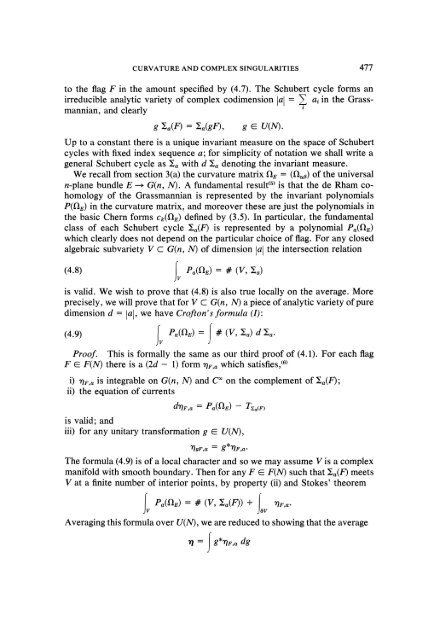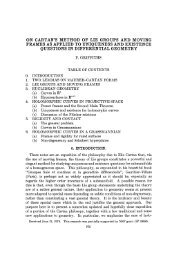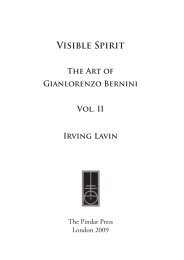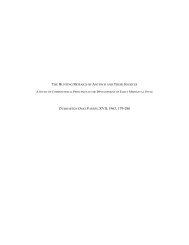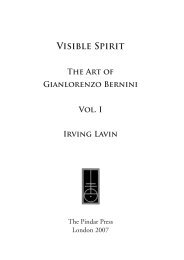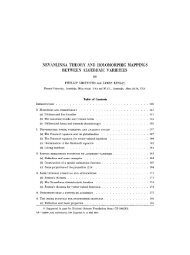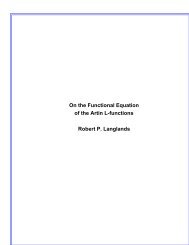View PDF - Project Euclid
View PDF - Project Euclid
View PDF - Project Euclid
Create successful ePaper yourself
Turn your PDF publications into a flip-book with our unique Google optimized e-Paper software.
CURVATURE AND COMPLEX SINGULARITIES 477<br />
to the flag F in the amount specified by (4.7). The Schubert cycle forms an<br />
irreducible analytic variety of complex codimension lal a in the Grassmannian,<br />
and clearly<br />
g Z.(F) X.(gF), g U(N).<br />
Up to a constant there is a unique invariant measure on the space of Schubert<br />
cycles with fixed index sequence a; for simplicity of notation we shall write a<br />
general Schubert cycle as E with d denoting the invariant measure.<br />
We recall from section 3(a) the curvature matrix f (fo) of the universal<br />
n-plane bundle E G(n, N). A fundamental result (5) is that the de Rham cohomology<br />
of the Grassmannian is represented by the invariant polynomials<br />
P(12) in the curvature matrix, and moreover these are just the polynomials in<br />
the basic Chern forms ce(f) defined by (3.5). In particular, the fundamental<br />
class of each Schubert cycle Ea(F) is represented by a polynomial<br />
which clearly does not depend on the particular choice of flag. For any closed<br />
algebraic subvariety V c G(n, N) of dimension [a the intersection relation<br />
Iv (4.8) Pa(f) # (V,<br />
is valid. We wish to prove that (4.8) is also true locally on the average. More<br />
precisely, we will prove that for V c G(n, N) a piece of analytic variety of pure<br />
dimension d [a I, we have Crofton’s formula (I):<br />
Iv (4.9) Pa(’E)= (V, ,a) f#<br />
Proof. This is formally the same as our third proof of (4.1). For each flag<br />
F F(N) there is a (2d 1) form rF,a which satisfies, (n)<br />
i) "OF, is integrable on G(n, N) and C on the complement of<br />
ii) the equation of currents<br />
d’OF,a Pa(I"E) TXa(F)<br />
is valid; and<br />
iii) for any unitary transformation g U(N),<br />
gF,a g*TIF,a"<br />
The formula (4.9) is of a local character and so we may assume V is a complex<br />
manifold with smooth boundary. Then for any F F(N) such that a(F) meets<br />
V at a finite number of interior points, by property (ii) and Stokes’ theorem<br />
fV Pa(’E) # (V, Xa(F)) + Iov TF’a"<br />
Averaging this formula over U(N), we are reduced to showing that the average


